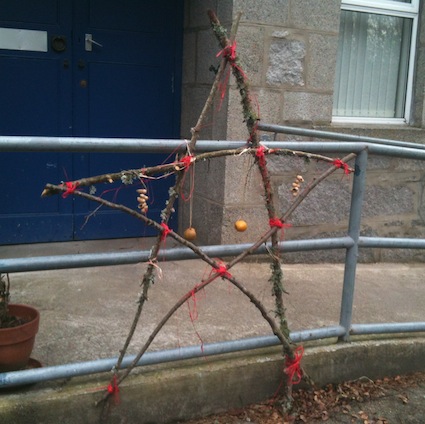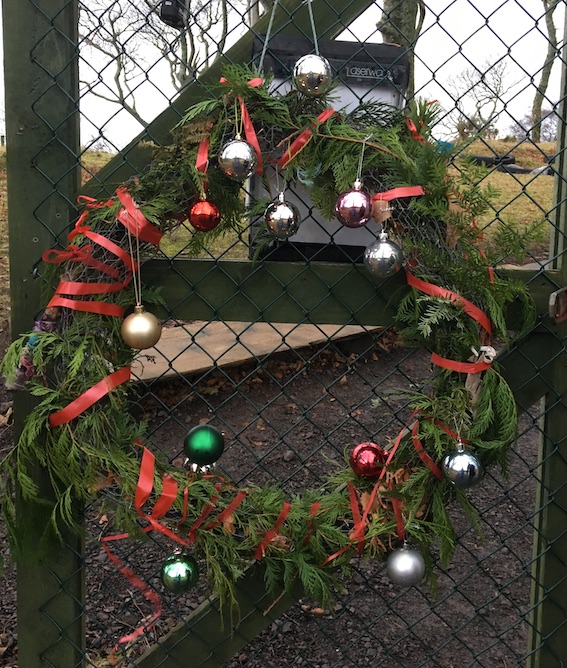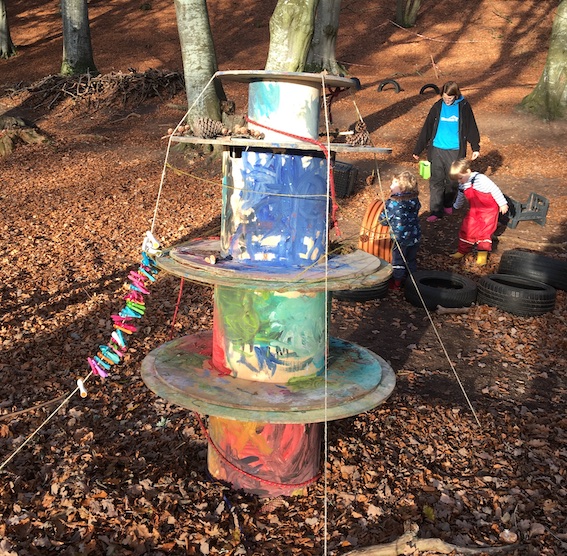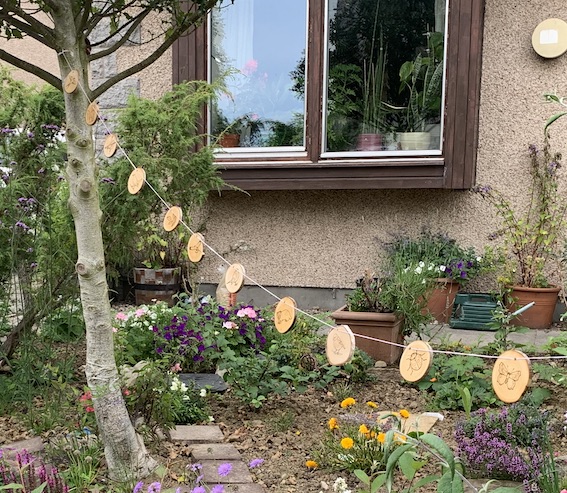
Here’s a few simple outdoor learning and play suggestions to do that can be easily squeezed into the hectic schedules in schools and pre-schools in the run up to Christmas. No more cabin fever. Let’s get out, get more sustainable and get going with free or low cost ideas.
If you work in Early Years, some words of wisdom from Mrs Thomson, a Visiting Teacher in Falkirk Council, “These are amazing, valuable, festive ideas. It’s important to remember that seasonal events and experiences should still be valuable, developmentally appropriate and fun for all children involved. Sometimes this can be contradicting in delivering some of the traditional events.” So keep these suggestions handy and be responsive to the children with whom you work. 🙂
1) Decorate a tree or bush outside as a bird feeding tree
- Smear pine cones in salt-free peanut butter or lard and dip in bird seed
- Make strings of popcorn
- Create birdseed fatballs to hang up
Enjoy watching quietly to see which birds come and visit. If you don’t have a tree, put a branch in a large pot filled with stones or peat-free compost. This can be useful to help children understand what food is okay for birds to eat, such as seeds and what items are best avoided such as breadcrumbs. For more ideas about creating natural feeding areas for birds, have a look at this blog post. To make the activity more mathematical, then look for bird food recipes online and adapt accordingly to whether your children are working with cups, decimal or metric units.
2) Look for Santa’s beard
When his Santa’s beard hair falls out, it lands all over the Earth and creates lichen. Have a hunt for some in your grounds or nearby greenspace. You will find lichen growing on rocks, old wall, gravestones, trees, roofs and fences. Give the children magnifying glasses to help see the lichen better. Lichen is very slow growing so it’s best to let the children take photos rather than pick off clumps. Lichens are often missed when it comes to learning about biodiversity yet are a core part of a healthy ecoystem and can be an indicator species that tells us if things are going well … or not! There are a number of website which offer downloadable ID guides. Do an online search, e.g. British Lichens.
3) Set up an outdoor nativity scene for small world play
Once children have heard the Christmas story, make animals or use toy farm animals. Buy some allergy-free hay from a pet shop. Get children to think of substitute possibilities for any animals and people you don’t have. For example, the children may enjoy creating animals from natural materials such a clay, sticks and cones. A large cardboard box turned on its side with flaps for the doors makes a simple stable which can be easily taken outside daily by children.Sometimes it’s possible to create a large set up in a shed rather than small world.
The learning potential is quite flexible here… it can be about empathy and relating to animals. Not all children may know what a sheep or cow is, let alone a donkey. How can you change this? Older children can use an outdoor nativity scene to adapt the nativity and change the plot, characters or setting if they know the Christmas story really well. Likewise, the best way of checking an older child’s understanding of a story is to get them to retell it in a creative way.
4) Take your nativity play outside (and into the community)
With the impact of Coronavirus, there has been more interest in holding outdoor nativity plays. A lovely example here is from Grasmere Primary School that used their whole village as the location for making a film about the nativity story. This film is suitable for children to watch and may give them ideas for developing their own outdoor plays.
5) A nature advent celebration
A spiritually deeper option is to go for the beautiful approach of Rudolph Steiner and Waldorf philosophy that build a nature advent display week-on-week in a very significant and deliberate way. It cumulates with a spiral walk through evergreen branches – clearly linked to the Winter Solstice traditions. Many thanks to Dr Elizabeth Henderson for letting me know about this. If you do an online search, you will find plenty of advice and photos for inspiration. All of this is easily transferable to an outdoor context, especially the advent spiral walk.
6) Go for a Christmas light walk
This is best in a residential area where children can look out for all the Christmas lights and other decorations. Look the variety of lights, indoors and out. Compare this with lights that are used all year round (a good reason for another walk in January). It can be also good to consider how to create your own set of lights back inside the classroom – do parallel circuits or lights in a series work best? Likewise, there may be inspirations for outdoor displays.
7) The Christmas tree walk
This is useful for schools and early learning settings based in woods or near places where seedling trees are growing. It’s originally inspired by Rachel Carson. You walk along and wonder what animals or people may like which sapling, depending on its size, e.g.
- That tree looks the perfect size for a beetle to decorate.
- This sapling looks about the right height for a red squirrel’s Christmas tree. They may want to hang their cones on this one.
- This tree looks big enough for a badger’s family. I wonder what they would use to decorate a tree.
Help children look for the tiny saplings growing and to find ways of avoiding stepping on them.
8) Sing Christmas carols outside
If you haven’t time to organize a visit to a community group, then brainstorm with your class to find songs to sing in different places, e.g
- Deck the Halls in the hall or a corridor
- The Holly and the Ivy beside a holly bush, if you have one in your grounds. If you don’t, find the thorniest bush instead or one with berries on it.
- Oh Christmas Tree!, near an evergreen tree, etc.
This can be a really interesting experiment – often singing sounds and feels different outside. Find out if any of your children have ever participated in a carol singing event outside.
9) Light cubbies and candle lanterns
Make the experience even more of an occasion by creating little torch or candle lanterns to take with you. A lovely example of building light cubbies can be seen on this video from Upper Sturt Primary School in South Australia which extends the learning throughout the primary stages and may be relevant for other religious festivals of light.

10) Follow the star
Set up a cardboard star trail around the school grounds. Children have to look for the stars hung in different places and complete the activities written on each star, e.g
- Do 10 star jumps
- Touch the grounds six times
- Walk backward 5 paces, etc.
Better still, the children could create their own ideas for a star trail. This works for all ages. Older children can create trails for younger children to follow. This is a useful way of being physically activity and children realising how to keep warm outside.
11) Create natural decorations and hang outside
It is possible to create simple stars from sticks and other natural materials. It can be useful for practising tying ribbon, weaving and other fine motor skills. Think about where would be a good place to put the decorations and who would want to enjoy seeing them. If you have cold weather, then use the opportunity to create ice decorations.
If you want to consider the maths opportunities of natural decoration, then check out this blog post for ideas. These are surprisingly challenging to do!
12) Go on a present hunt
Wrap up a box in used gift paper or some material (waterproof stuff is ideal for damp, wet days). Take turns at hiding the box in different places outside for other children to find. Children can give clues such as “getting warmer” as a child gets closer to the box and “going cold” if a child moves further away or in the wrong direction. Your class may enjoy make their own gift boxes and deciding what free and found treasures should go in them. With older classes, this can be adapted to create a more complex hunt with clues and instructions. Alternatively, you could undertake a simplified version in French or another language.
13) Re-use unwanted decorations
If your children love the glitzy look of Christmas decorations, then reuse old and unwanted Christmas decorations outside. Be aware that tinsel can shed and some decorations have glitter that can fall off – so only use decorations which do not pose a risk to other species or the land.
- Use Christmas ribbon and shiny material to decorate the features of your outdoor area. Weave ribbon through fences, around hanging baskets and tubs. Just ensure the material won’t dissolve in the rain and wet weather. This could be part of the fun, deciding which materials will work best. If a child does choose materials that go soggy then, let them and observe what happens. Most children learn experientially.
- Hang plastic baubles on the fences and washing lines. Sorting, ordering and making patterns can arise through this sort of play.
- Using guttering, roll plastic baubles down the guttering. See what happens when water is added. Use baubles of different shapes and sizes for comparison.

14) Create a grotto for Santa outside
This is an adaptation of a den building challenge. You need to provide children with materials for den building but add in unwanted baubles and other items to make the grotto look interesting, e.g.
- It needs to be big enough to house Santa sitting on a seat, a child by his side and lots of presents
- It needs to provide Santa with shelter from the weather: wind, rain, snow
- It needs to look inviting for children both at a distance and close up. What can you do to create an attractive entrance and pathway leading up to the grotto?
14) Have a special Christmas outdoor snack
Provide warm drinks such as warm spicy apple juice and warm foods such as mince pies outside. They do seem to taste extra good outdoors. Check out some more warm outdoor snacks and food options in this blog post. What Christmas food is possible to cook outside? Likewise, if your school or nursery celebrates other traditions, think about which traditional recipes work could be cooked on a campfire or made and eaten outside.
15) Reindeer prints
Look online to find the pattern and spacing of reindeer hooves. Create a set of prints in the ground that disappear. Wonder with the children about where they have gone to, how they landed and so on. This is especially exciting after a visit from Santa and a good invitation into creative writing for older children. Likewise it could be a gateway activity into looking at different wildlife tracks.
16) Find out about outdoor traditions, stories and plants associated with Christmas
Many plants are associated with Christmas… holly, ivy, fir trees, etc. Find out more about holly here. The Woodland Trust have a lovely idea for a nature Christmas scavenger hunt for traditional natural items as well as advice about looking out for UK wildlife which could be seen around Christmas.
17) Winter solstice
This is a lovely celebration with lots of outdoor potential. Have a look at the Slow Family blog by Suz Lipman for an explanation of the Winter Solstice and some relevant traditions which could be explored by your class.
18) Create a “Giving Back to Nature” Advent Calendar
This idea was proposed by Emma Halley who established The Nature Nursery. Each day of advent has a wee box. The aim is to fill each box with an item that benefits nature in some way. Naturally the children will have their own ideas and it could be a scavenger hunt in advance. Alternatively, the boxes could be filled by staff and then used as a wee learning moment as each day another box is opened and used.
19) Create your own count down calendar.
Count downs to the holidays do not need to be about chocolate or religion. There’s lots of daily outdoor ways of celebrating such as:
- In 2021, Plantlife Scotland released a daily native flower video celebrating the Gaelic name and other facts about our native plant species.
- With your class, develop a list of 24 outdoor or nature based experiences to undertake.
- At its most simple, hang a decoration outside on a tree and enjoy counting the collection as it grows.
- Adapt the book All Creation Waits for your local animals. Whilst it is based on the Christian faith, the concept need not be taught in this way, if you or your school prefers. As the blurb states, “Each day of Advent a different animal shows children its own amazing way to meet the dark and cold. Wood Frog freezes into a frog-shaped cube of ice! For six months Painted Turtle doesn’t breathe! Woodchuck can’t be wakened, even if shaken! With each creature, children hear the refrain: The dark is not an end. It’s a door. It’s the way a new beginning comes.” Many thanks to Joe Pound for this suggestion.
20) A spidery Christmas
Spider’s webs are wonderful to look at on cold winter’s days or nights when the frost hangs from the webs. Go looking for them. This is nature’s original tinsel: sparkly, beautiful and a gift of freezing cold weather. You are extra lucky if you find them on fir trees – nature’s original tree decorations! Can you find the spiders too?
21) A stick Christmas tree
These are very absorbing to make and useful for children still learning the concept of long, longer, longest. Alone, in pairs or groups the children collect an agreed number of sticks lying on the ground. These have to be laid in order from smallest to largest to create a triangle. “Decorations” such as little leaves, berries or other natural found objects can also be added. If you only have an asphalt playground, then consider collecting or asking for donations of sticks in advance of the activity. Teach your children to be aware of the value of dead wood and to leave lichen-covered or rotting sticks in situ.
22) Junk Christmas trees
No Christmas tree and no money? Fear not! Use what you’ve got. Ask your children to find or source items that can be safely stacked on top of each other to create junk ones. In the photo below, Stramash Elgin Outdoor Nursery secured the cable drums once the children had painted each one. Check out the choice of decorations too which could be added to … or removed! It is magnificent!

23) Nature bunting
It’s very simple – attached leaves, threads of berries, pine cones, wooden discs and any other natural materials to twine to hang up between trees. The beauty of nature bunting is that it is adaptable to any religious or non-religious celebration or event.

24) A festive Daily Mile
If your class is undertaking the Daily Mile, then why not make it a festive fancy dress occasion. There’s no need for to buy costumes – they could be tricky to run in. But just attaching a plastic bauble to a hat or wearing something green, white or red could make the occasion a bit special.

25) Play on the Darkest Day
This is a wonderful non-religious celebration of play. You will need to check your dates and sunrises and sunsets to work out precisely which day this is, but usually it is around 21st December. It is a wonderful way to wrap up term and prepare for the holidays ahead. For play in the dark suggestions, see here.
Finally….
I’ve a few more Christmas posts worth browsing from previous years. Check out: A Christmas Tree Enterprise for starters. Always remember to tidy up sparkly man-made items that wildlife may find appealing. The tiny fragment are hard to tidy up outside and quickly becomes litter that is not okay for wildlife to ingest, edible or otherwise.Try to avoid using glitter, tinsel and similar products as much as possible.
This blog post has been updated most years since the first post was written in December 2010.




















LOVE so many of these ideas. The Christmas walk is genius. We are on vacation right now and it is a bit warmer so I think we might have to do this one this morning.
Thanks for sharing all these ideas.
I sincerely hope you are a teacher at a Christian school, and not a public school! If it’s the latter, then you are purposefully alienating many students, and that is NOT acceptable, or constitutional.
Hello Andrea
Thanks for taking the time to comment. I’m based in Scotland, within the UK where by law, schools have to teach religious and moral education (RME). This includes Christianity and other world religions. Parents have a legal right to withdraw their children from acts of religious observation in Scottish schools.
I have been extremely fortunate to work with amazing parents and children with many different religious beliefs and have always consulted with them prior to organising Christmas activities to find out what is and is not acceptable for their child to be involved with. I try to take an inclusive and sensitive approach to the teaching of RME.
I trust the readers of my blog to be able to take the information contained in this post and apply as much or as little of it as appropriate to their context.
I hope this clarifies matters.
Best wishes
Juliet
Where is your blog about outdoor Winter Solstice activities then? Honestly, that would be much more fitting. This seems awfully Christian-centric.
Andrea,
What a fabulous idea!
Now that you have put this suggestion to me, I think this blog post is a definite must. Watch this space.
Thank you very much
Juliet
OK so I never managed a Winter Solstice post this festive period. However Suz Lipman has over at her blog http://www.slowfamilyonline.com/2013/12/celebrate-the-winter-solstice-2/ so enjoy the info and suggestions posted there.
Andrea S. I don’t understand why you are taking such a critical and aggressive stance when Juliet has been nothing but helpful sharing her ideas. I find your attitude rude .
What a fabulous blog. I’ve just used this with my class of 6 year olds. In the class there were muslims, hindus, Sikhs, catholics, one Jehovah witness, protestant and agnostics. It was a great way to inform them of traditions from another culture/religion. Andrea S – I doubt any of their parents will be offended or feel their child has been alienated, as they all came to watch their children in the nativity play last week and had no issues. As a community we all stayed and chatted afterwards.
Thanks for your comments!
I totally agree, Juliet your responses have shown you are the ultimate professional. Thank you for your ideas…. Within Early Years it’s important to embrace all faiths and beliefs including Christian festivals. Thank you again your ideas.
Thanks Trish – Eventually I’ll get other light festivals up or linked. Strangely as a teacher of P1/T1/G1 I always had an emphasis on Hannukah as such a positive celebration and so child-friendly. What’s interesting is that I first created this post in 2010 – and since then the Winter Solstice has become more and more popular to celebrate… Play on the Darkest Day is another universal event that celebrates this too in a non-religious way.
Andrea how is exploring the Festival of Christmas excluding others. In Scotland we celebrate lots of festivals from a range of world religions to develop both understanding and tolerance. Religious education is quite different from Religious Instruction.
Hi Juliet
I love every idea you have detailed in your blog. Living in beautiful Sydney, Australia, we have ample opportunities to get outside in the sun and explore. I will be taking your ideas with me to the Preschool I work at and I’m sure ALL the kids will thoroughly enjoy them. Thank you so much for your creative ideas.
Best Wishes for a wonderful Christmas, Sharna Fish.
Thanks Sharna 🙂
Tinsel is deadly to birds and animals if they eat it. It should never be put outside….or used for that matter because the tree will eventually end up outside.
The other ideas are wonderful
Thanks Michelle
I think this is a really helpful point and perhaps one I should have flagged up in the post. Any of the unwanted decorations pose hazards to wildlife if not properly considered. Broken items should be removed promptly along with any traces of shiny litter!
Best wishes
Juliet
Some great ideas Juliet, I particularly love the star hunt and peanut butter cones for the birds. Thanks for linking up and sharing some fab outdoor activities with Country Kids.
Great ideas! It’s easy to adjust any “religious” activity to other holidays/seasons. Thankfully, the creativity, open-mindedness, and love of teachers like you bring joy and happiness to all children throughout the year.
Valarie – This is a very valid point. I am researching the Winter Solstice and so many of the traditions are blended into Christmas or general holiday that it becomes quite hard to know what is specifically religious and what is not. Years ago, I worked with a talented classroom assistant who was a Jehovah’s Witness. She was really helpful in terms of clarifying these sorts of matters so I may have to go to her for further advice.
I like these ideas! Will hopefully try set up an outdoor nativity and definitely have an outdoor Christmas snack, everything tastes better outside!
Love the post. I felt it was totally seasonal and not overtly Christian! Even if it was overtly Christian I would still be thanking you for sharing your ideas and inspiration, just as I like sharing in my Jewish and Hindu friends’ celebrations. One of the great things about the web is sharing and learning from each other and not having to to conform to some culturally diluted Stalinist tight rope of political correctness. I think the inclusive nature of the UK RE curriculum fosters understanding and inclusiveness and I have realised today I should be grateful for this. Thank you!
Thanks Ruth – I rather like the Scottish approach to RME as it is not prescriptive and celebrates and values all religions and cultural events. I think most people would recognise that Christmas is as much a cultural event as a religious event these days in Scottish society. However I do try and remember that my perspective may not be shared by parents and children that I teach so I suppose being gently cautious helps.
Loved your Christmas ideas! Made the star and attached as a bird feeding station in forest school last week with Early Years. They loved it! They problem solved how to make the star, practised their knot tying skills and thread monkey nuts, popcorn, Cheerios and dried fruit onto cotton and wool and had an altogether wonderful time! Thank you 🙂
Thanks for the feedback Kay Jo – It’s always good know know when ideas turn out to be useful to others. Happy Christmas to you, your children and the birds that visit!
These are great ideas, thank you for sharing.
Juliet, I sincerely appreciate you sharing these ideas. Will use ‘Follow the Star’ as an activity to follow the reading of ‘Little Owl and the Star: A Christmas Story’ by Mary Murphy. The Star tells all of the principal characters in the Nativity story to “follow me”, as he is on his journey to shine above the stable. We will then go outside and follow the stars to the forest school area to find our advent calendar which will begin our own period of ‘waiting’ (advent). A lovely start to Christmas celebrations. Thank you.
Catherine
What a brilliant development of this idea! I really hope the activity goes well. Thanks for sharing – I hope it inspires others.
Hello, Thank-you for sharing your creative ideas! I have just weaved together two big stars and look forward to sharing with the children as they made feeders to hang on the Christmas star..
Thankyou again xx
You’re welcome – it sounds wonderful what you have done. Happy birds too!
I love these outdoor ideas. Tree decoration is the best activity kids like to play. Thank you so much for sharing these fun loving activities.
Hi Juliet! Some great ideas as always. I love decorating a tree for the birds and like to link it to the story “Night Tree” by Eve Bunting. It’s basically about a family that every Christmas Eve decorates a tree in the forest. They cover it with apples, seed balls, popcorn garlands etc. as a gift to the animals. Also has carol singing and outdoor snacks! I have done it at Stramash a few times, but now wondering if we can do it another way. Thanks for the inspiration!
Ooh – I didn’t know about this book – it sounds like a lovely springboard into the bird tree decorations. In fact it reminds me – It would be good to check out some Christmas story books and see what outdoor activities these naturally lend themselves to.
Thanks so much for all these great ideas! I will be using a few for our “Fresh Air Fridays.” As a Christian educator, I really appreciate your suggestions. So sorry that there are people out there that cannot be kind and keep negative comments to themselves. Thanks for all these activities!
Hello Anne – Thanks for taking the time to comment. I’m aware that there’s many festivals from other religions that I have yet to cover and perhaps one year I’ll be organised enough to blog about these in advance of winter coming. Enjoy your Fresh Air Fridays!